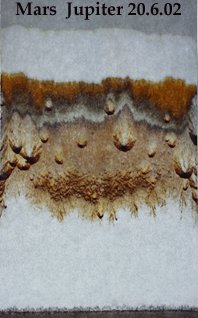|
||||||
| A Chemical Theatre | ||||
| 'A type of symbolism which can be
traced back to sources much more ancient than any we have for alchemy is the association
of metals with the planets.' F.Sherwood Taylor, Origins of Greek alchemy, Ambix I
p.46. Experiments with metal salts in solution can show the effect of the planets that 'correspond' with the metals. The basic procedure for these experiments was developed by Kolisko in the 1930s, following some indications from Rudolf Steiner. They are chromatographic, in that a precipitation reaction takes place slowly as solutions rise up a filterpaper. It was Kolisko's genius to realise that the ionic reaction between solutions of silver nitrate and ferrous sulphate is slow, so that colloidal silver is gradually precipitated over say three to ten minutes. These metals correspond to, respectively, the Moon and Mars. Gradually, precipitation-patterns fan out on the filterpaper, which can be somewhat three-dimensional looking. Next, Kolisko showed that the pattern formed by the precipitations varied depending on when it was performed, and specifically over conjunctions in the sky of the Moon and Mars, which happens once a month. Thereby she initiated the idea of a time-experiment. Contrary to the fundamental axiom of modern science, that a chemical reaction can be repeated at any time and will be the same, she showed over years of these experiments that what she called the 'formative force' gave differing pictures. |
||||
| One
could say that this is the Moon-nature of silver, to be receptive, sensitive and
impressionable. She also added some lead nitrate, which gave more heavy-looking pictures.
These took longer to form. Lead is the Saturn-metal. The pictures shown here are mainly
using lead-added, and therefore performed over Saturn-conjunctions: just with the Moon, as
happens once a month, or with Mars, as happens once every two years. The best series of experiments was performed by Mike Drummond, who followed the Mars-Saturn conjunction of 1976, and then the trine, square and sextile! One does these experiments before, during and after, and one set a day for the two-planet meetings. For a Moon-event, which is much more fast-moving one does a set every half-hour or hour. (We used the modification of the method by Agnes Fyfe, who worked at the Lukas Klinic at Arlesheim. This just used smaller quantities, 1% solutions, and the special convenient petri-dishes they make. You will often hear these filterpaper-pictures referred to as 'steigbild' which is the German word for it. I was able to get these Mars-Saturn experiment filterpapers analysed using an atomic absorption spectrophotometer! This showed conclusively that the lead was behaving differently over the days of the Saturn-conjunction in the heavens. Normally, during a celestial event, the typical 'forms' will disappear from the filterpaper, will be in some way washed out, and will then gradually reappear again. Various persons have reported results from an experiment over a Mars-Saturn conjunction: firstly Kolisko in her Saturn und Blei of 1952, then Dr Karl Voss in 1964 (in his Neue Aspekte journal), then Rudolf Haushka in 1949 (reported in Pelikan's The Secrets of Metals 1973). I obtained some dramatic results from the Mars-Saturn conjunction of 1971, but was not well able to photograph the results (The filterpapers will spoil if exposed to undue light and moisture, as silver is so light-sensitive). Then Drummond followed with the 1976 experiment. The aim of this website, is to try and show what the filterpapar pictures look like, during the celestial events. So we invite anyone with such data, to send them in and we'll put them on display. It is only fair to add that, several persons involved in these experiments have concluded that they have not worked so well in recent decades, presumably due to the intense mantle of man-made radiations now enmeshing the planet. To quote what I wrote on them back in 1976: A sequence of identical experiments, performed before, during and after the event, will therefore mirror the changes undergone by the planetary influences. The sequence of experiments then functions as a kind of microcosmic theatre, enabling the progress of a celestial event to be followed. For a fine review of the literature, see John T. Burns, Cosmic Influences on Humans, Animals and Plants, Magill 1997 (US).
|
||||
